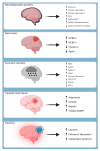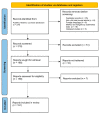The Role of Adipokines in the Pathologies of the Central Nervous System
- PMID: 37834128
- PMCID: PMC10572192
- DOI: 10.3390/ijms241914684
The Role of Adipokines in the Pathologies of the Central Nervous System
Abstract
Adipokines are protein hormones secreted by adipose tissue in response to disruptions in physiological homeostasis within the body's systems. The regulatory functions of adipokines within the central nervous system (CNS) are multifaceted and intricate, and they have been identified in a number of pathologies. Therefore, specific adipokines have the potential to be used as biomarkers for screening purposes in neurological dysfunctions. The systematic review presented herein focuses on the analysis of the functions of various adipokines in the pathogenesis of CNS diseases. Thirteen proteins were selected for analysis through scientific databases. It was found that these proteins can be identified within the cerebrospinal fluid either by their ability to modify their molecular complex and cross the blood-brain barrier or by being endogenously produced within the CNS itself. As a result, this can correlate with their measurability during pathological processes, including Alzheimer's disease, amyotrophic lateral sclerosis, multiple sclerosis, depression, or brain tumors.
Keywords: Alzheimer’s disease; adipokines; adipose tissue; depression; encephalitis; meningitis; multiple sclerosis; neurological dysfunctions; protein hormones.
Conflict of interest statement
The authors declare no conflict of interest.
Figures


References
-
- Sako W., Ishimoto S. Can Cystatin C in Cerebrospinal Fluid Be a Biomarker for Amyotrophic Lateral Sclerosis? A Lesson from Previous Studies. Neurol. Clin. Neurosci. 2014;2:72–75. doi: 10.1111/ncn3.82. - DOI
-
- Langlois V. Laboratory Evaluation at Different Ages. In: Geary D.F., Schaefer F., editors. Comprehensive Pediatric Nephrology. Elsevier; Amsterdam, The Netherlands: 2008. pp. 39–54.
Publication types
MeSH terms
Substances
LinkOut - more resources
Full Text Sources
Medical
Research Materials

